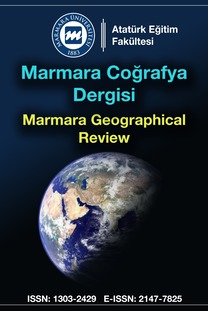LONDRA'DAKİ TÜRK NÜFUSUN MEKANSAL DAĞILIMI
Dünyanın birçok yerinde bulunan Türk göçmenler göç edilen yer ve göç süreci gibi sebeplerden dolayı gittikleri yerlerde kendine özgü bir göç tecrübesi oluştururlar. Bu bağlamda, İngiltere'deki Türkler de İngiltere'de bulunan diğer göçmen toplulukları ve Avrupa'nın diğer ülkelerindeki Türklere kıyasla birçok açıdan farklılıklara sahip olması bu kendine özgülüğün en önemli göstergelerinden birisidir.İngiltere'de Türkler denildiği zaman Londra'daki Türkler; Londra'daki Türkler denildiği zaman da Kuzey Londra'nın Enfield, Harringey, Hackney ve Islington ilçeleri akla gelmektedir ve şehrin bu bölgesinde, yoğun Türk nüfusuna paralel olarak market, kebapçı, restoran gibi iş/emek mekânları; dernek, kahvehane, okul, cami, cemevigibi toplumsal ve kültürel mekânların varlığı ile adeta 'Küçük bir Türkiye' olarak isimlendirilen bu bölge her ne kadar anavatan ile benzerlikler gösterse de kendine özgü özellikleri olan bir yerdir. Bu çalışmanın birinci amacı; Londra'daki Türk mekânlarını resmederek bu bölgeyi hangi unsurların özgün kıldığını sorgulamaktır. Bu amaca temel oluşturacak şekilde bir diğer amaç ise, Londra'daki Türklerin göç tarihi ile beraber Türk nüfusu hakkında bilgi vermektir.
The Distribution of Turkish Population in London
Turkish migrants, which are in the diverse area of the world, has special and unique experience due to the attitudes of host countries and the process of migration. In this context, Turkish community in London has greatly different features in the respect of both other migrant communities in United Kingdom and Turkish migrants in other European countries. Turkish population in London intensify in the districts of North London such as Enfield, Haringey, Hackney and Islington, and this region is called "The Small Turkey" due to having so many labour spaces owned by Turkish people such as markets, kebap shops and restaurants, and due to the number of social and cultural spaces such as organizations, coffee houses, schools, mosques, cemevis that Turkish people frequent. Even if the region has some features of both the homeland and the host country, it is a unique and distinctive place. Thus, my first aim in this paper is to describe the places belong to Turkish people in London, and to examine what makes the region distinctive and to informbriefly the history of Turkish migration and Turkish population in London.
___
Ansari, H. (2004).The infidel within: Muslims in Britain since 1800, C. Hurst & Co. Publishers,London.Constantinides, P. (1977). "The Greek Cypriots: factors in the maintenance of ethnic identity", in Watson, J.L. (ed.) Between Two Cultures: Migrants andMinorities in Britain, Oxford, Basil Blackwell, 269-300.
Düvel, F.(2000).Turkish Migration toth UK, Oxford, Centre on Migration, PolicyandSociety (COMPAS).
Enneli, P.,Modood, T., and Bradley, H. (2005). Young Turks and Kurds: A set of 'invisible' disadvantaged groups, York,, Joseph Rowntree Foundation/University of Bristol.
Erdemir, A., and Vasta, E. (2007)."Differentiating irregularity and solidarity: London", COMPAS Working Paper (ESRC Centre on Migration, Policy and Society, University of Oxford) 42. in
Home Affairs Committee,(2011).Implications for the Justice and Home Affairs area of the accession of Turkey to the European Union, The Stationery Office, London.
King, R., and Bridal, J. (1982)."The changing distribution of Cypriots in London", Etudes Migrations, 65, s. 93-121.
Ladybury, S. (1977)."The Turkish Cypriots:ethnic relations in London and Cyprus", in Watson, J.L. (ed.) Between Two Cultures: Migrants and Minorities in Britain, Oxford, Basil Blackwell, 301-331.
Mehmet Ali, A. (2001). Turkish Speaking Communities and Education - No Delight, Fatal Publications, London.
Oakley, R. (1989)."Cypriot migration to Britain prior to World War II", New Community, Vol. 15, No. 4, s. 509-25.
Önal, A. (2000)."İngiltere'deki Türkiyeli Topluluk Üstüne Bir Çalışma" http://www.gazetem.net/bellekyazi.asp?yaziid=67/VeriBilgi1 5.10.2013
Robins, K., and Aksoy, A. (2001). "From spaces of identity to mental spaces: lessons from Turkish Cypriot cultural experience in Britain",Journal ofEthnic and Migration Studies, 27 (4): 685- 711.
Sonyel, R. (1988). The Silent Minority: Turkish Muslim Children in British School, Cambridge, The Islamic Academy.
TC Dışişleri Bakanlığı, (2013)."Yurt Dışında Yaşayan Türkler", http://www.mfa.gov.tr/yurtdisinda-yasayan-turkler_.tr.mfa/ VeriBilgi27 Nisan 2013.
Thomson, M., Mai, N., and Keles, Y.(2007).2nd MIGSYS Report - "Turks' in the UK". Brighton, Sussex Centre for Migration Research.
Thomson M., King, R., Keles, Y. and Mai, N.(2008) Turks in London: Shades of Invisibility and Shifting Relevance of Policy in the Migration Process Brighton, Sussex Centre for Migration Research
Uysal, A. (2014). Londra'da Türk Varlığı: Mekan ve Aidiyet, Basılmamış Doktora Tezi, İstanbul, İnstanbul Üniversitesi Sosyal Bilimler Enstitüsü.
Yılmaz, I. (2005).Muslim Laws, Politics and Society in Modern Nation States: Dynamic Legal Pluralisms in England, Turkey and Pakistan, Aldershot, Ashgate.
- ISSN: 1303-2429
- Yayın Aralığı: Yılda 2 Sayı
- Başlangıç: 1997
- Yayıncı: Marmara Üniversitesi
Sayıdaki Diğer Makaleler
ÇATALAĞZI YÖRESİ'NDE (ZONGULDAK) TERMİK ENERJİ YATIRIMLARI
SOSYAL BİLGİLER ÖĞRETMEN ADAYLARININ İNSAN HAKLARI VE DEMOKRASİ DERSİNE İLİŞKİN GÖRÜŞLERİ5
ENERJİ KULLANIMININ ÇEVRESEL ETKİLERİNİN İNCELENMESİ23
ORHAN ÇOBAN, NAZAN ŞAHBAZ KILINÇ
SARIKAMIŞ BAYRAKTEPE (CIBILTEPE) KIŞ SPORLARI VE TURİZMİ MERKEZİNE AİT COĞRAFİ BİR DEĞERLENDİRME8
İSTANBUL ADALARI'NIN MEKAN-KIYI YÖNETİMİ VE SÜRDÜRÜLEBİLİRLİK KAPSAMINDA PLANLANMASI7
Nuriye GARİPAĞAOĞLU, Sibel ÖZCAN
ÜNİVERSİTE ÖĞRENCİLERİNİN TÜRK DÜNYASI COĞRAFYASINA İLİŞKİN FARKINDALIK DÜZEYLERİNİN BELİRLENMESİ4
EVLİYA ÇELEBİ'NİN (17. YÜZYIL) "İKLİM" ANLAYIŞI VE SEYAHATNAME'DE BELDELERİN İKLİMİ
GEÇMİŞTEN GÜNÜMÜZE ÖNEMLİ BİR SAYFİYE: GÖLCÜK
